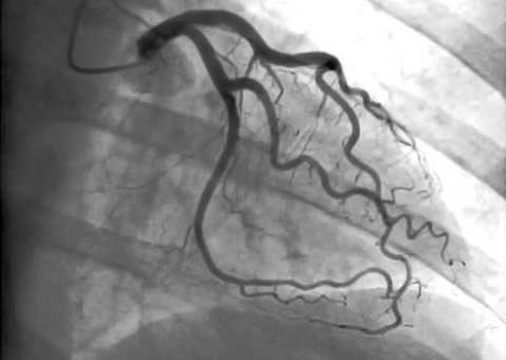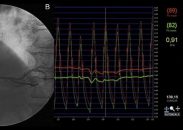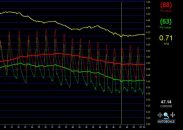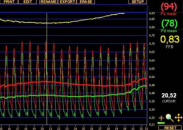Original Title: Effect of the presence and type of angina on cardiovascular events in patients without known coronary artery disease referred for elective coronary angiography. Reference: Vavalle JP et al. JAMA Cardiology 2016; Epub ahead of print. Patients presenting typical angina with a negative stress test result prior catheterization have a high rate of heart…
Is normal FFR always good prognosis?
Original Title: Coronary Flow Reserve and Microcirculatory Resistance in Patients with Intermediate Coronary Stenosis. Reference: Joo Myung Lee, el al. J Am Coll Cardiol 2016; 67:1158-69 Courtesy of Dr. Carlos Fava. Measuring fractional flow reserve (FFR) helps establish whether intermediate stenosis will generate ischemia, but it won’t help assess microcirculatory function. It has been shown that…
LEMANS Trial: Left main stenting vs. surgery at 10 years
Original Title: Left main stenting in Comparison with Surgical Revascularization 10-year outcomes of the (Left Main Coronary Stenting) LE MANS trial. Reference: Buszman P et al. J Am CollCardiolIntv. 2016;9(4):318-327. doi:10.1016/j.jcin.2015.10.044. Courtesy of Dr. Guillermo Migliaro. Long term outcomes of left main stenting are unknown. This study reports 10 year follow up outcomes of the LEMANS trial patients. The…
Impact of the Right Atrial Pressure on FFR measurement
Original Title: Impact of the Right Atrial Pressure on Fractional Flow Reserve Measurements Comparison of Fractional flow Reserve and Myocardial Fractional flow Reserve in 1600 Coronary Stenosis. Reference: Toth G, et al. JACC Cardiovasc Interv. 2016 Feb 12. Epub ahead of print. Courtesy of Dr. Guillermo Migliaro. Fractional Flow Reserve (FFR) is the gold standard for the…
Should ranolazine be considered for all incomplete revascularization patients?
Original Title: Effects of Ranolazine in Angina and Quality of Life after Percutaneous Coronary Intervention with Incomplete Revascularization Results from the Ranolazine for Incomplete Vessel Revascularization (RIVER-PCI) Trial. Reference: Karen P. Alexander et al. Circulation. 2016 Jan 5;133(1):39-47 Courtesy of Dr. Santiago Alonso Persistence or return of angina after PCI is relatively frequent, which is why…
Diabetes has higher impact on DES outcomes than disease complexity
Original Title: Impact of diabetic status on outcomes after revascularization with drug-eluting stents in relation to coronary artery disease complexity. Reference: Koskinas KC et al. Circ Cardiovasc Intv. 2016; Epub ahead of print Diabetic patients ongoing PCI with drug eluting stents (DES) are at higher risk of repeat revascularization than non-diabetic patients. According to this…
Incomplete Revascularization in the Long Term
Original Title: Long-Term Outcome of Incomplete Revascularization after Percutaneous Coronary Intervention in SCAAR (Swedish Coronary Angiography and Angioplasty Registry). Reference: Kristina Hambraeus et al. J Am Coll Cardiol Intv. 2016;9(3):207-215. The aim of this study was to describe the evolution of patients with multivessel disease undergoing PCI with incomplete revascularization, and its probable association to…
Cutoff FFR Values, What to Do in the “Grey Zone”
Original Title: Significance of Intermediate Values of Fractional Flow Reserve in Patients with Coronary Artery Disease. Reference: Julien Adjedj et al. Circulation. 2016 Jan 5. Epub ahead of print. The fractional flow reserve (FFR) value of 0.75 has been validated against tests for inducible ischemia, whereas the value 0.80 has been widely accepted to guide the…
Definite/Probable Thrombosis with Bioresorbable Scaffolds
Original Title: Scaffold Thrombosis After Percutaneous Coronary Intervention With ABSORB Bioresorbable Vascular Scaffold. A Systematic Review and Meta-Analysis. Reference: Michael J. Lipinski et al. J Am Coll Cardiol Intv. 2016;9(1):12-24. The authors of this study carried out a systematic review and a meta-analysis to determine the thrombosis risk of the bioresorbable everolimus eluting scaffold ABSORB (Abbott…
Meta-Analysis of Bioresorbable Vascular Scaffolds vs. Everolimus Eluting Stents
Courtesy of Dr. Agustín Vecchia. The aim of this study was to compare the safety and efficacy of bioresorbable everolimus eluting scaffolds (BVS) vs. everolimus eluting stents (EES) in patients with ischemic heart disease. Medline, Embase, the Cochrane Central Register of Controlled Trials (CENTRAL), was searched for scientific sessions, abstracts, and relevant websites for…
Long Term Outcomes of Routine vs. Provisional T-stenting for De Novo Coronary Bifurcations: Five Year Outcomes of the BBK-I Trial
Original Title: “Long-term outcomes of routine versus provisional T-stenting for de novo coronary bifurcation lesions: five-year results of the Bifurcations Bad Krozingen I study”. Authors: Miroslaw Ferenc, MD; Mohamed Ayoub, MD; Hans-Joachim Büttner, MD; Michael Gick, MD; Thomas Comberg, MD; Jürgen Rothe, MD; Christian M. Valina, MD; Willibald Hochholzer, MD; Franz-Josef Neumann, MD. Division of Cardiology and…










